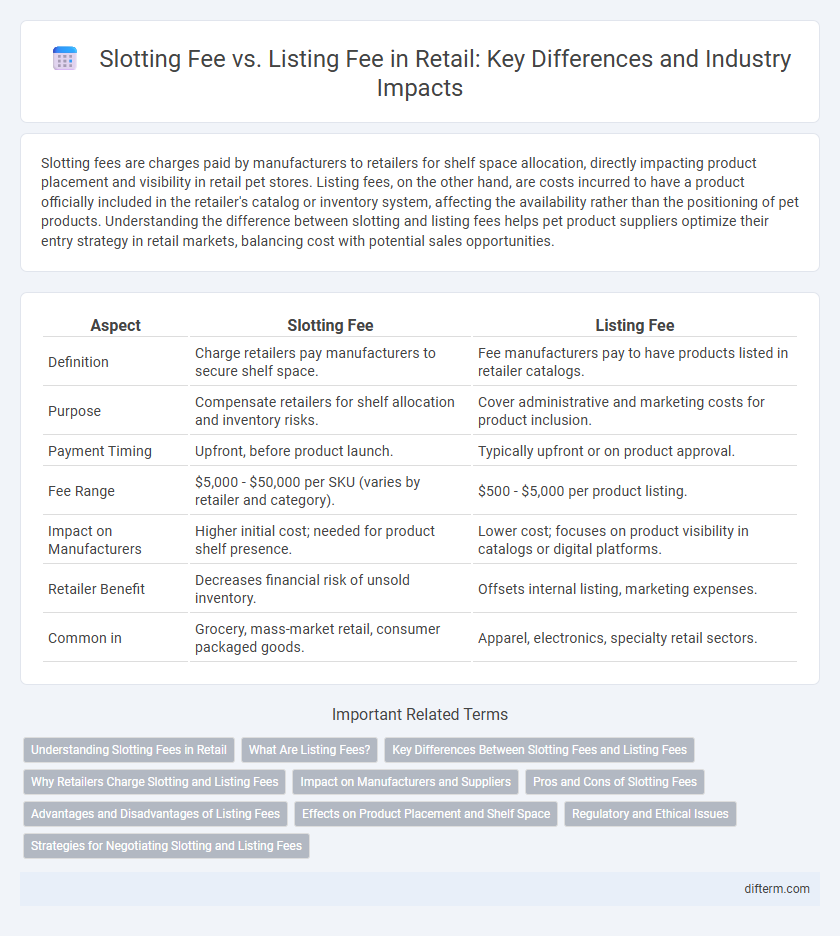Slotting fees are charges paid by manufacturers to retailers for shelf space allocation, directly impacting product placement and visibility in retail pet stores. Listing fees, on the other hand, are costs incurred to have a product officially included in the retailer's catalog or inventory system, affecting the availability rather than the positioning of pet products. Understanding the difference between slotting and listing fees helps pet product suppliers optimize their entry strategy in retail markets, balancing cost with potential sales opportunities.
Table of Comparison
| Aspect | Slotting Fee | Listing Fee |
|---|---|---|
| Definition | Charge retailers pay manufacturers to secure shelf space. | Fee manufacturers pay to have products listed in retailer catalogs. |
| Purpose | Compensate retailers for shelf allocation and inventory risks. | Cover administrative and marketing costs for product inclusion. |
| Payment Timing | Upfront, before product launch. | Typically upfront or on product approval. |
| Fee Range | $5,000 - $50,000 per SKU (varies by retailer and category). | $500 - $5,000 per product listing. |
| Impact on Manufacturers | Higher initial cost; needed for product shelf presence. | Lower cost; focuses on product visibility in catalogs or digital platforms. |
| Retailer Benefit | Decreases financial risk of unsold inventory. | Offsets internal listing, marketing expenses. |
| Common in | Grocery, mass-market retail, consumer packaged goods. | Apparel, electronics, specialty retail sectors. |
Understanding Slotting Fees in Retail
Slotting fees in retail refer to the charges manufacturers pay to retailers to secure shelf space for new products, ensuring prominent visibility and favorable placement. Unlike listing fees, which are paid to get a product included in a retailer's catalog or system, slotting fees are specifically tied to the physical allocation of space on store shelves. Understanding slotting fees is crucial for brands as these costs directly impact product launch strategies, inventory planning, and overall retail profitability.
What Are Listing Fees?
Listing fees are charges retailers impose on suppliers to include their products in store catalogs or online marketplaces, ensuring shelf space or digital presence. These fees cover costs related to product placement, marketing, and inventory management, influencing product visibility and sales potential. Unlike slotting fees that focus on physical shelf allocation, listing fees primarily pertain to the administrative and promotional aspects of product introduction within retail channels.
Key Differences Between Slotting Fees and Listing Fees
Slotting fees are charges that retailers impose on manufacturers to secure shelf space for new products, focusing primarily on physical placement and inventory risk. Listing fees, on the other hand, are fees paid to retailers simply to have a product included in their catalog or system, regardless of shelf presence. The key difference lies in slotting fees being directly tied to shelf allocation and associated costs, while listing fees relate to product acceptance and catalog inclusion without guaranteeing physical display.
Why Retailers Charge Slotting and Listing Fees
Retailers charge slotting fees to compensate for the limited shelf space and the risk of stocking new products that may not sell well, ensuring optimal inventory management and maximizing sales per square foot. Listing fees are imposed to cover the administrative costs of adding new products to their catalogs, including system updates, vendor coordination, and marketing efforts. These fees help retailers maintain profitability while offering a diverse product assortment to consumers.
Impact on Manufacturers and Suppliers
Slotting fees require manufacturers to pay retailers for shelf space, creating upfront costs that can limit small suppliers' market access and impact cash flow. Listing fees, charged for product inclusion in a retailer's catalog or system, influence product visibility but often involve ongoing costs tied to inventory levels or sales performance. Both fees affect manufacturers' pricing strategies and profitability, with slotting fees posing a significant barrier to entry while listing fees shape long-term supplier-retailer relationships.
Pros and Cons of Slotting Fees
Slotting fees, charged by retailers to manufacturers for shelf space, enable better inventory management and reduce the risk of carrying unprofitable products. However, these fees can create barriers for small or emerging brands, limiting market diversity and innovation. Despite generating immediate revenue for retailers, slotting fees may discourage product variety and increase costs passed to consumers.
Advantages and Disadvantages of Listing Fees
Listing fees offer retailers upfront revenue and help manage product assortment efficiently by controlling the number of SKUs on shelves. However, these fees can pose a financial barrier for small suppliers and limit product diversity, potentially reducing innovation in the retail space. Retailers must balance the advantage of stable income against the disadvantage of possibly alienating emerging brands and limiting consumer choice.
Effects on Product Placement and Shelf Space
Slotting fees directly influence product placement by determining the priority and visibility a product receives on retail shelves, often resulting in premium shelf space for higher-paying brands. Listing fees primarily cover the cost of adding a product to the retailer's catalog but do not guarantee optimal shelf positioning or increased shelf space. Therefore, slotting fees have a more significant impact on strategic product placement and consumer accessibility in retail environments.
Regulatory and Ethical Issues
Slotting fees and listing fees in retail raise significant regulatory and ethical concerns related to market fairness and transparency. Regulatory scrutiny often focuses on whether slotting fees create barriers for smaller suppliers, potentially violating antitrust laws by limiting market access. Ethical issues arise from potential exploitation of suppliers, requiring retailers to ensure fee structures do not disproportionately disadvantage emerging brands or manipulate shelf space allocation.
Strategies for Negotiating Slotting and Listing Fees
Effective negotiation of slotting and listing fees requires thorough market research on competitor fee structures and product performance metrics to establish a strong bargaining position. Emphasizing product uniqueness, sales projections, and promotional plans enhances leverage when proposing fee adjustments or waivers to retailers. Utilizing data-driven arguments and demonstrating potential ROI can lead to more favorable terms and lower upfront costs in retail partnerships.
Slotting fee vs Listing fee Infographic

 difterm.com
difterm.com